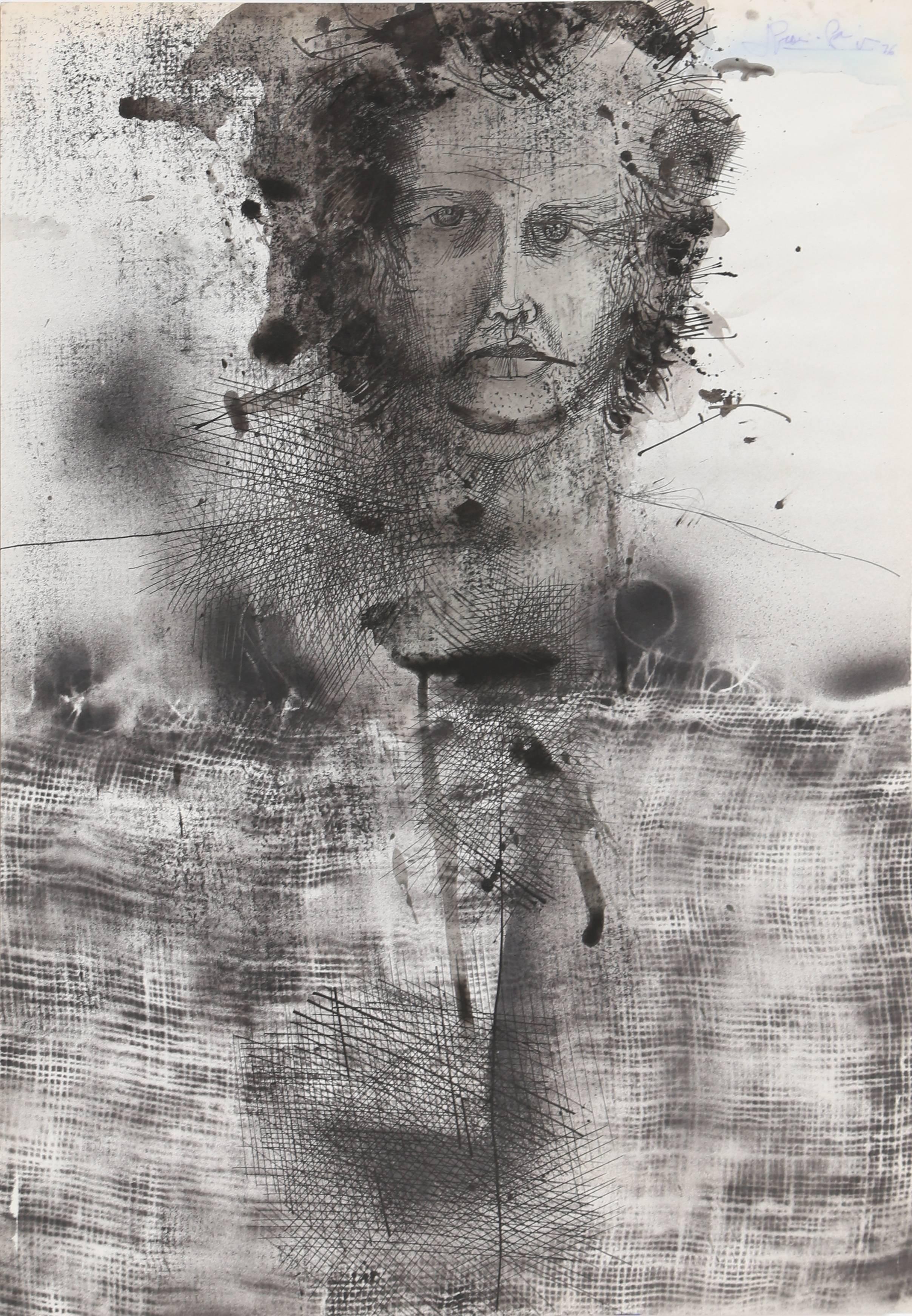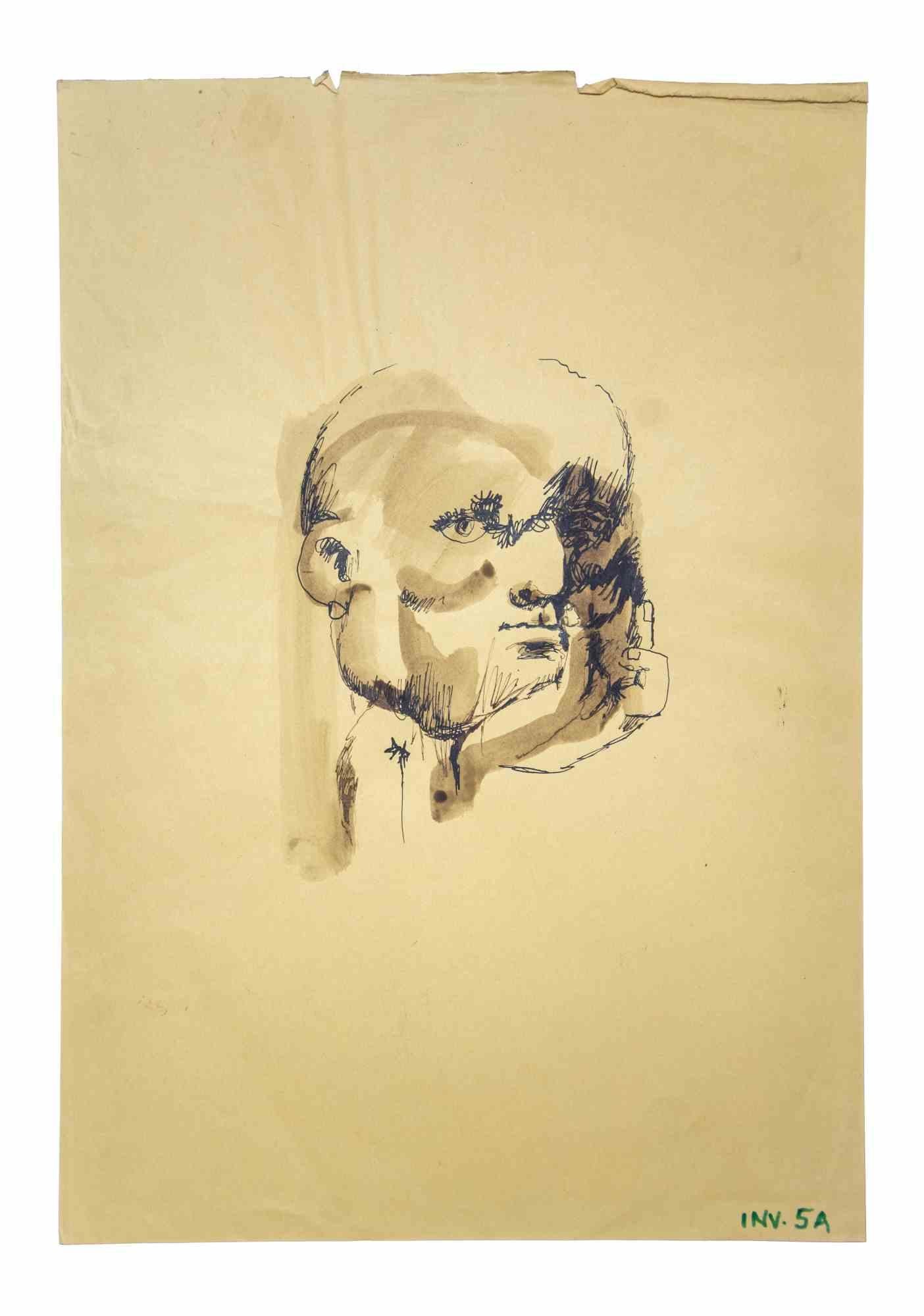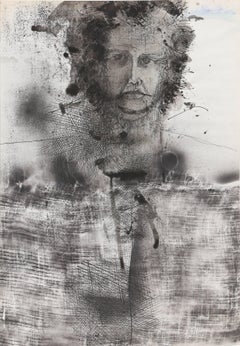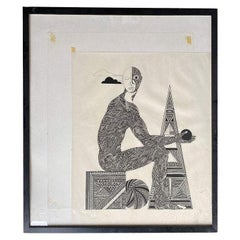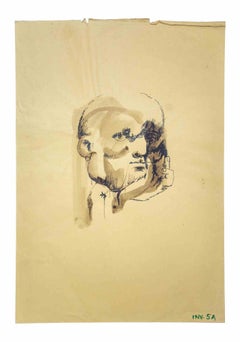Items Similar to John A Self Portrait Framed Original Ink Drawing Modern Irish Mid-20th Century
Want more images or videos?
Request additional images or videos from the seller
1 of 23
John KingerleeJohn A Self Portrait Framed Original Ink Drawing Modern Irish Mid-20th Century1967
1967
$2,596.95
£1,895
€2,210.83
CA$3,557.17
A$3,956.35
CHF 2,065.88
MX$48,144.54
NOK 26,384.46
SEK 24,743.97
DKK 16,500.24
Shipping
Retrieving quote...The 1stDibs Promise:
Authenticity Guarantee,
Money-Back Guarantee,
24-Hour Cancellation
About the Item
John Kingerlee.
Irish ( b.1936 ).
John, 1967. A Self-Portrait.
Ink On Paper.
Signed & Dated Lower Left.
Image size 11 inches x 8.5 inches ( 28cm x 21.5cm ).
Frame size 15 inches x 12.4 inches ( 38cm x 31.5cm ).
Available for sale; this original drawing is by John Kingerlee and is dated 1967.
The drawing is presented and supplied in a sympathetic contemporary frame (which is shown in these photographs), mounted using conservation materials and behind glass.
This vintage drawing is in very good condition, commensurate with its age. It wants for nothing and is supplied ready to hang and display.
The drawing is signed and dated lower left.
John Kingerlee is a wonderfully unconventional Irish painter of both abstract and figurative work. He is particularly known for his expressionist Grid Reference works and Rub-Back works. He has few, if any, parallels in contemporary art
John was born on 14th February 1936, Valentine’s Day, in Birmingham. His mother was Irish and though he later lived in London he received a Catholic education at a school run by the Marist Fathers. He lived then for some twenty years in Cornwall, moving in 1992 to an isolated farmhouse in the Beara Peninsula in West Cork, Ireland. He is a convert to Islam and has a second family in Fez, Morocco.
For the last twenty years, he and his wife Mo have lived for long periods in virtual isolation, growing their own organic vegetables and John working from his studio, which practically hangs over the ocean.
Their lifestyle, like the work the John produces, is unconventional, harmonious and worthy. John finds inspiration in the wilderness and beauty of their surroundings and sees his engagement with nature as a multi-sensory experience. His output is diverse and prolific, and he has produced stunning art work in mixed media, drawings, collage and ceramics.
John Kingerlee had no formal training in art and did not start to paint until his thirties. Whilst he has drawn on many literary and artistic influences he has developed his own naïve expressionist style. He takes an original and radical approach to perspective. In his studio he uses his own made up pigments, using strong direct colors and often building paintings up in organic layers, like the crust of the earth in a process that might comprise a hundred or more layers and take several years. He typically uses a palette knife and a decorator’s brush for his larger paintings. He will have several pieces of work in progress at any one time.
The works of John Kingerlee have been exhibited extensively, from 1967 onwards, in numerous international locations including London, Dublin, Belfast, Cork, Texas, Beverly Hills, Florida, Beijing, Nashville, Georgia, Pennsylvania, and New York,
New York Times art critic William Zimmer gave a speech about the artist and his works at the Los Angeles exhibition in October 2006 in which he said; “With some disingenuousness Kingerlee has described himself as an outsider artist. No one this well travelled could qualify as one and yet there is some truth in his statement. He is operating outside the art world that grabs all the attention; that which is high on technology and resembles popular entertainment more than traditional art practices. John Kingerlee’s art is triumphant because it transcends all such props. It is based in an imagination sustained by enchantment, observed reality and superlative talent.”
Kingerlee’s “Grid Composition” was sold at Sotheby’s, New York in 2006 for a record £82,591.
Kingerlee’s work has been the subject of many academic reviews and critical appraisals, including the publication ‘The Whole Planet is a Garden, the genius of John Kingerlee” by Edmund P. Pilsbury
The works of Kingerlee are today found in many international collections and galleries including the Crawford Art Gallery in Cork and the national gallery of Poland, the Ireland Fund and the collection of BP Ireland.
It has been said that his work literally fizzles with energy as if seen through the eyes of a child creating friendly innocent like beings, goblins and animals from a cosmic world. This seems to apply particularly well to the drawings offered here.
© Big Sky Fine Art
This brilliant and appealing self-portrait executed as a line drawing is stunning in its simplicity and character. It is at once sophisticated yet almost childish, even fantastical. It depicts a head and shoulders of a naked man, holding a single flower, perhaps a daisy in his left hand. He is gazing at the flower, and in the background the horizon is shown as a sketched line, and the sun as a large incomplete circle. His hair is wild and fuzzy, his ears pointed like a pixie and his chin is unshaven. The overall effect is naive, but quite magical.
- Creator:John Kingerlee (1936, Irish)
- Creation Year:1967
- Dimensions:Height: 14.97 in (38 cm)Width: 12.41 in (31.5 cm)
- Medium:
- Movement & Style:
- Period:
- Condition:This vintage drawing is in very good condition, commensurate with its age. It wants for nothing and is supplied ready to hang and display.
- Gallery Location:Sutton Poyntz, GB
- Reference Number:1stDibs: LU489314041612
About the Seller
5.0
Vetted Professional Seller
Every seller passes strict standards for authenticity and reliability
Established in 2010
1stDibs seller since 2016
122 sales on 1stDibs
Typical response time: 1 hour
- ShippingRetrieving quote...Shipping from: Sutton Poyntz, United Kingdom
- Return Policy
Authenticity Guarantee
In the unlikely event there’s an issue with an item’s authenticity, contact us within 1 year for a full refund. DetailsMoney-Back Guarantee
If your item is not as described, is damaged in transit, or does not arrive, contact us within 7 days for a full refund. Details24-Hour Cancellation
You have a 24-hour grace period in which to reconsider your purchase, with no questions asked.Vetted Professional Sellers
Our world-class sellers must adhere to strict standards for service and quality, maintaining the integrity of our listings.Price-Match Guarantee
If you find that a seller listed the same item for a lower price elsewhere, we’ll match it.Trusted Global Delivery
Our best-in-class carrier network provides specialized shipping options worldwide, including custom delivery.More From This Seller
View AllEnigma 1960s Eccentric And Bohemian Framed Original Welsh Abstract Oil Painting
By Meryl Watts
Located in Sutton Poyntz, Dorset
Meryl Watts.
English ( b.1910 – d.1992 )
Enigma.
Oil On Board.
Signed Lower Right.
Image size 22.4 inches x 19.3 inches ( 57cm x 49cm ).
Frame size 26.4 inches x 22.8 inches ( 67cm x 58cm ).
Available for sale; this original oil painting is by Meryl Watts and dates from the mid-1960s.
The painting is presented and supplied in its’ original hand painted frame (which is shown in these photographs).
This vintage painting is in very good condition, commensurate with its age. It wants for nothing and is supplied ready to hang and display.
The painting was created whilst Watts resided at 1 Bron Avon, Borth-y-Gest, Porthmadog. (Today’s postcode would be LL49 9TU).
The painting is signed lower right.
Meryl Watts was born on the 5th April 1910, the only child of Charles and Evelin Watts. They lived in Germains Place, Blackheath and she was raised in east end of London where her father was a printer.
She studied at the Blackheath Art School, where the Principal was John Edgar Platt, one of the major artists using the technique of color woodcut. She learned this technique from Platt and was influenced by his style, as shown in the attractive and colorful designs that she subsequently produced.
Meryl began to work independently in 1937, producing her own work while still living in Blackheath. During World War II the family home and business were destroyed by German bombing and Meryl and her parents were given just a few hours to collect whatever valuables they could before their house was demolished to protect neighboroughing properties from further damage. As a consequence much of her early work was lost.
Having left their home the family evacuated to Portmeirion in Wales, where they had frequently stayed on holiday before the war. They struck up a friendship with the Portmeirion architect and founder, Sir Clough William-Ellis. Portmeirion was founded in 1925 and took nearly fifty years to complete. It was a homage to Sir William-Ellis’ love of the Italian Riviera and incorporated the grounds of a twelfth century castle. The resort became extremely popular with tourists and was the backdrop for various TV programs and films, including The Prisoner. Meryl Watts became artist in residence at Portmeirion, and over the next few years she produced an abundance of artwork including sketches, oil paintings and watercolors of famous scenes from the Snowdonia coastal region and other traditional landmarks. This was a new and very successful chapter of her artistic career.
From Portmeirion Meryl and her parents moved to a rented house in Borth-Y-Gest, Caernarvonshire, North Wales. In 1944 Meryl’s father purchased the house and Meryl began to work there, using the endless views in the area for her inspiration. After the death of her father in 1957 and her mother in 1969 Meryl lived alone in Borth-y-Gest until she married Professor Joseph Allen...
Category
Mid-20th Century Abstract Abstract Paintings
Materials
Oil, Board
I Can’t Stay Away From You 1980s Vintage Painting Mature Female Nude In Cornwall
By John Emanuel
Located in Sutton Poyntz, Dorset
John Emanuel .
English ( b.1930 ).
I Can’t Stay Away From You.
Watercolor & Ink.
Signed Lower Right.
Image size 28.3 inches x 19.9 inches ( 72cm x 50.5cm ).
Frame size 35.2 inches x...
Category
Late 20th Century Modern Nude Drawings and Watercolors
Materials
Paper, Watercolor, Ink
Moonlight Embrace Male & Female Nude En Grisaille Watercolor Picasso Influence
Located in Sutton Poyntz, Dorset
Keith Bayliss.
Welsh ( b.1954 ).
Moonlight Embrace.
Watercolor & Ink.
Signed Lower Left.
Image size 10.4 inches x 14.4 inches ( 26.5cm x 36.5cm ).
Frame size 16.7 inches x 20.1 inc...
Category
Late 20th Century Constructivist Nude Drawings and Watercolors
Materials
Paper, Ink, Watercolor
Horse & Rider Modern British Northern Art Manchester Salford Original Watercolor
By Geoffrey Key
Located in Sutton Poyntz, Dorset
Geoffrey Key.
English ( b.1941 ).
Horse and Rider, 1988.
Watercolor & Ink On Paper.
Signed & Dated Lower Left.
Image size 10 inches x 6.7 inches ( 25.5cm x 17cm ).
Frame size 16.1 inches x 12.6 inches ( 41cm x 32cm ).
Available for sale; this original painting is by Geoffrey Key and is dated 1988. The painting is presented and supplied in a sympathetic and contrasting contemporary frame (which is shown in these photographs) to suit the subject coloration, mounted using conservation materials and behind glass.
The artwork and its presentation is in very good condition. It wants for nothing and is supplied ready to hang and display.
The watercolor is signed and dated lower left.
Geoffrey Key is a leading figure in Northern contemporary art, widely regarded as Lancashire’s greatest living artist, noted for his realism, his expressive use of bold color and his graphic, linear style. His striking works, now much in demand, have established him as a major player of post war British figurative art.
Geoffrey Key was born in Rusholme, Manchester in 1941. His mother, Marion, worked as an illustrator and encouraged him to draw and he took to this easily and with great enthusiasm. He was educated at Manchester's High School of Art, whose headmaster, Ernest Goodman, established the Salford Art Club. It is fitting that many years later, after Goodman's death, its members chose Geoffrey Key as Honorary President. In 1958 Key enrolled at the Manchester Regional College of Art, where he was tutored by the sculptor Ted Roocroft and the painter Harry Rutherford, both of whom influenced him greatly. After gaining the National Diploma of Design and the Diploma of Associateship of Manchester, the latter with distinction, Key took up a postgraduate scholarship in sculpture.
His academic awards include the Heywood Medal in Fine Art and the Guthrie Bond Travelling Scholarship.
Geoffrey Key’s early work included an important period of development during which he concentrated on painting and drawing a specific area of the Derbyshire landscape, the Whiteley Nab hill, south of Glossop. Key created literally hundreds of images of this one landscape and later revealed that the sole purpose of this dedicated period of study, was to build upon the firm foundation established by his academic training, whilst divesting himself of the influences he had absorbed in order to arrive at his own personal artistic language. In other words, this is where he found his own style.
After graduating Key worked as a teacher at Duke Street Secondary Modern in Broughton, Salford, which later became Broughton Modern. In every spare moment though he painted and his talent was quickly recognised. As the likes of Salford Art Gallery, The Rutherston Loan Collection and North West Arts began to acquire his work he made the decision to relinquish his salary and to become a full time artist.
Key was elected to membership of the Manchester Academy of Fine Arts in 1968 and was a prize winner in 1971. During this time he was also commissioned by three North West England based companies – Mather & Platt, Richard Johnson & Nephew, and Wilson’s Brewery. The Richard Johnson & Nephew pictures are now held by the Museum of Science and Industry, Manchester.
In the 1980s the French company Société des Caves de Roquefort also commissioned Key’s work and further successful exhibitions were held in both the UK and abroad. In 1987 the Manchester Evening News asked Key to write an article on L. S. Lowry, who Key had known well, for a feature marking the centenary of the artist's birth. This article was accompanied by a contemporary drawing of Lowry by Key. Apart from LS Lowry, Key is arguably Lancashire’s best-known and most collected contemporary artist. Key says ‘I knew Lowry and he was a lovely...
Category
Late 20th Century Cubist Animal Drawings and Watercolors
Materials
Paper, Ink, Watercolor
Hawk Bird Of Prey Framed Original Mid 20th Century Powerful Watercolor Painting
By Elisabeth Frink
Located in Sutton Poyntz, Dorset
Dame Elisabeth Frink.
English ( b.1930 - d.1993 ).
Hawk, 1969.
Watercolor.
Signed & Dated Lower Right.
Image size 25.4 inches x 19.5 inches ( 64.5cm x 49.5cm ).
Frame size 34.4 inches x 28.1 inches ( 87.5cm x 71.5cm ).
Available for sale; this original painting is by Dame Elisabeth Frink and is dated 1969.
The painting is presented and supplied in a glazed frame and mount dating from June 1997.
This vintage watercolor is in very good condition, commensurate with its age.
The watercolor is signed and dated lower right.
Previously with Beaux Arts, London and Bath in 1999.
Dame Elisabeth Frink was one of Britain’s most important post-war sculptors, an accomplished draughtsman, illustrator and teacher. She was part of the post-war school of expressionist British sculptors dubbed the Geometry of Fear, and enjoyed a highly acclaimed career that was commercially successful, broke boundaries and contributed greatly to bringing wonderful sculpture to public places.
She was born on 14 November 1930 in Thurlow, the daughter of a cavalry officer, and brought up in rural Suffolk near to an active airbase. She was brought up a Catholic and educated at the Convent of the Holy Family, Exmouth.
She then studied at the Guildford School of Art from 1947-1949 under Willi Soukop and Henry Moore’s assistant, Bernard Meadows, and then at the Chelsea School in London 1949-1953. She taught at Chelsea School of Art 1951-61, St. Martin’s School of Art 1954-62 and was a visiting instructor at the Royal College of Art 1965-1967, after which she lived in France until 1973.
Frink first came to the attention of the public in 1951 at an exhibition at the Beaux Arts Gallery, London. In 1952 she represented Britain at the Venice Biennale, being described by Herbert Read as “the most vital, the most brilliant and the most promising of the whole Biennale”. The same year the Tate bought its first work by her, and she began to enjoy commercial success. Thereafter she exhibited regularly and was for 27 years associated with Waddington’s, London.
The subjects which Frink was most concerned with were man, dog and horses, with and without riders. Interestingly she seldom sculpted the female form, drawing on archetypes of masculine strength, struggle and aggression. Her work has the recurring themes of the vulnerable and the predatory, in the spirit of an authentic post-war artist. It has been said that she was more concerned with representing mankind that portraits of individuals.
The appeal of her work lies in its directness, provoking a frank statement of feeling. The anatomy is often exaggerated or incorrect; the impact growing more out of her interest in the spirit of the subject. Her animals and birds may be drawn from nature but verge on the abstract, conveying raw emotion and character rather than a realistic depiction. Her unique style is characterised by a rough treatment of the surface which embeds each piece with vitality and her personal impression. In her later work even the distinction between human and bird figures becomes blurred. Commentators have noted that the often rugged, brutal and contorted surfaces of her work reflect the destruction and terror of the six-year world-wide conflict that she witnessed as a child. Frink was an active supporter of Amnesty International.
In the 1960s and early 1970s Frink produced a notable series of falling figures and winged men. Later, living in France during the Algerian war, she began making heads, blinded by goggles which had a threatening facelessness.
Frink produced many notable public commissions, including Wild Boar for Harlow New Town, Blind Beggar and Dog for Bethnal Green, Noble Horse and Rider for Piccadilly, London, a lectern for Coventry Cathedral, Shepherd for Paternoster Square beside St. Paul’s Cathedral and a Walking Madonna for Salisbury Cathedral. In the early 1980s she produced a set of three larger than life figures The Dorset Martyrs which stand on the edge of the old walled town of Dorchester on the site of the old gallows, as a memorial to those who had been executed there ‘for conscience sake’.
Frink’s Canterbury Tales was a collection of 19 etchings drawn directly on to copper plates and etched by her. The ‘book’ was issued in three limited editions. Her illustrations have been praised as “amongst the most successful illustrations of the century, encompassing the mood of the text in concise delineations and disarmingly ribald humour”. She illustrated other books with colored lithographs or drawings.
Frink was on the Board of Trustees, British Museum from 1976, and was a member of the Royal Fine Art Commission 1976-81. CBR (1969), DBE ((1982), Associate of the Royal Academy (1971), Royal Academy (1977). She was made a Companion of Honour in 1992. She died on 18 April 1993, but not before completing her last commission, a monumental but unusual figure of Christ for the front of the Anglican Cathedral in Liverpool, unveiled a week before her death.
For several decades Frink exhibited widely in the UK and abroad. In her later years she lived and worked in Dorset where her home and garden became an arena for her work.
In 1985 she had a retrospective at the Royal Academy. She died on 18 April 1993, but not before completing her last commission, a monumental but unusual figure of Christ for the front of the Anglican Cathedral in Liverpool, unveiled a week before her death. There was a memorial show at Yorkshire Sculpture Park, Bretton Hall in 1994.
Today Frink is venerated as one of the great twentieth century British sculptors. Her unique work is represented in the Tate Gallery and major public and private collections world-wide.
© Big Sky Fine Art
This original watercolor on paper painting of a hawk by Dame Elizabeth Frink...
Category
Mid-20th Century Modern Animal Paintings
Materials
Paper, Watercolor
Lady In The Sea Holzhandler Polish Jewish Heritage Original Naïve Pastel Drawing
By Dora Holzhandler
Located in Sutton Poyntz, Dorset
Dora Holzhandler.
French - British ( b.1928 - d.2015 ).
Lady In The Sea.
Pastel & Felt Pen On Paper.
Signed & Dated 2007 Lower Right.
Image size 10.8 inches x 8.3 inches ( 27.5cm x 21cm ).
Frame size 17.7 inches x 15.2 inches ( 45cm x 38.5cm ).
Available for sale is this original pastel and pen drawing on paper by Dora Holzhandler dated 2007. The artwork is presented and supplied in a sympathetic contemporary frame (which is shown in these photographs), mounted using conservation materials and behind non-reflective glass.
This piece is in superb condition. It wants for nothing and is supplied ready to hang and display.
The artwork is signed lower right.
Dora Holzhandler was an exceptional artist of Polish-Jewish descent who escaped Nazi persecution in Europe to forge a successful career in Britain.
She was discovered by artist Victor Pasmore in 1947 and had her first exhibition in 1954. She continued to exhibit for more than sixty years.
Today her paintings are on display in the Museum of Modern Art in Glasgow and the Jewish Museum London as well as many museums and collections both in the UK and abroad.
Dora Holzhandler was born to Jewish-Polish parents, who had fled anti-semitic persecution in their native Warsaw and met and married in London. They were living in Paris when Dora was born on 22nd March 1928. Her father had fought for the British Army in WW1 and gained British nationality. He was a handbag maker and her mother was a seamstress. Their livelihood suffered as the world economy moved into recession following the Great Crash and Dora was fostered for five years by a French farming family in Normandy. She returned to Paris in 1933 and became close to her maternal grandfather, a devout rabbi, who was later killed in Auschwitz. In 1934, she moved to London where the family lived as part of the vibrant Jewish community in the East End, and was evacuated to Norfolk, aged eleven, at the outbreak of WW2.
In 1948 Holzhandler returned to Paris where she studied French literature at the Sorbonne and attended the Académie de la Grande Chaumière, founded in 1902 by Swiss artist, Martha Stettler...
Category
21st Century and Contemporary Symbolist Figurative Drawings and Watercolors
Materials
Paper, Felt Pen, Pastel
You May Also Like
Self Portrait, 1970's Ink Drawing by Josep Grau-Garriga
By Josep Grau-Garriga
Located in Long Island City, NY
Artist: Josep Grau-Garriga, Spanish (1929 - 2011)
Title: Self Portrait II
Year: circa 1976
Medium: Ink on Paper
Size: 28 x 24 in. (71.12 x 60.96 cm)
Category
1970s Abstract Expressionist Portrait Drawings and Watercolors
Materials
Ink
Hand Inked on Paper Surrealist Male Portrait Drawing Signed Ken Kreel 1989
Located in Van Nuys, CA
Hand-inked artwork on Paper Surrealist Male Portrait Etching Signed Kea Kreel 1989. The print features an intricate detailed scenic with a man in contemplation against geometric shap...
Category
Vintage 1980s American Drawings
Materials
Paper
$1,537 Sale Price
44% Off
Surrealist Portrait - Original Etching (Plate signature), 1946
By Jean Cocteau
Located in Paris, IDF
Jean Cocteau
Surrealist Portrait, 1946
Original etching
Printed signature in the plate
On BFK Rives vellum, 32,5 x 25 cm (c. 12,7 x 9,8 inch)
Edition limited to 300 copies (unnumber...
Category
1940s Expressionist Figurative Prints
Materials
Etching
Portrait - Ink and Watercolor Drawing by Leo Guida - 1970s
By Leo Guida
Located in Roma, IT
Portrait is an original artwork realized in the 1970s by the Italian Contemporary artist Leo Guida (1992 - 2017).
Original watercolor and ink on paper.
Good conditions, except fo...
Category
1970s Contemporary Figurative Drawings and Watercolors
Materials
Watercolor, Ink
Long Face, Abstract Expressionist Ink and Wash Painting by Abraham Rattner
By Abraham Rattner
Located in Long Island City, NY
Artist: Abraham Rattner, American (1895 - 1978)
Title: Man with Long Face
Year: 1961
Medium: Ink and Wash on Paper, signed, dated and dedicated to Sue Salinas
Size: 10 x 8.5 inches
...
Category
1960s Abstract Expressionist Portrait Drawings and Watercolors
Materials
Ink, Watercolor
Face I, Painting, Chinese Ink, Portrait of Man by PadmaBhushan Artist "In Stock"
By Akbar Padamsee
Located in Kolkata, West Bengal
In this case an ordinary working Man, This alluring work in a 15 x 11 inches ( Unframed ) and 23 x 19 inches (framed) in Ink on paper is a signature work by the master artist Akbar P...
Category
Early 2000s Modern Figurative Drawings and Watercolors
Materials
Paper, Ink
More Ways To Browse
Original Large Drawing
Mid Century Modern 1967
John Wills Painting
Ocean Drawing
Nude Self Portrait
Irish Original Art
Nude Mother
Irish Painters
Mother Child Drawing
Irish School
20th Century Irish Art
Texas Mid Century Modern
John Ireland
William Ireland
Vintage Irish Signs
Manning Of Ireland
Naked Drawing
Naked Man
